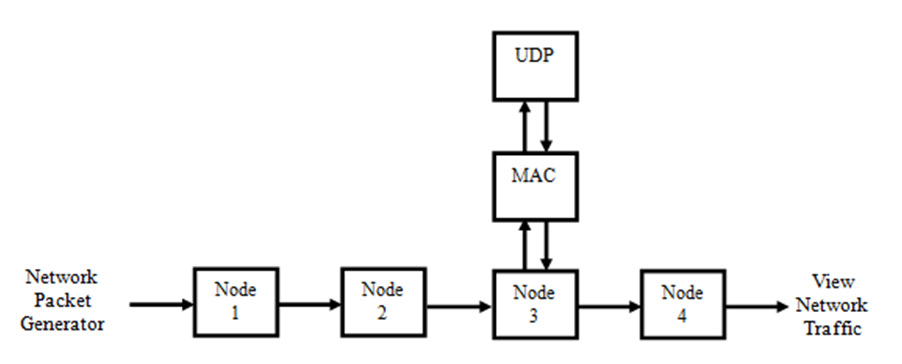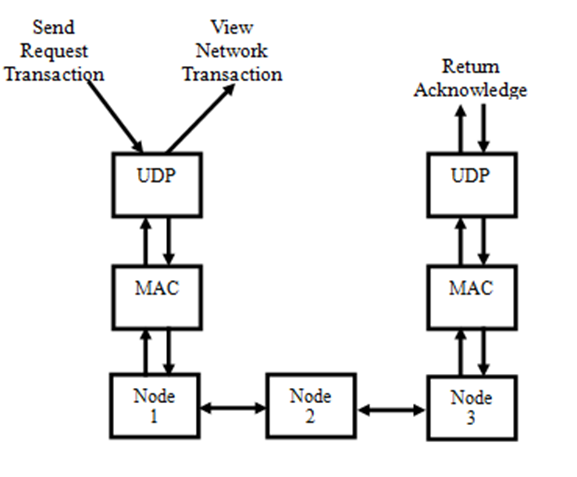Network Application Library Laboratory
Goals
The following laboratories will focus on
developing network architectures using the network block
libraries. The goals of this set of network-oriented laboratories
are as follows:
The linear and star network topologies seem to be a good start for any network model construction. Therefore, the laboratories will focus on the following topologies:
VisualSim Architect has many library blocks that could
be used for the development of system models. The list below can
be used initially to develop network architectures.

Laboratory 1: Linear Network Block Diagram
The focus of this laboratory is to use the basic
network library blocks to build a network with a connected linear
topology as given above. A few things to remember:
1. The transactions sent over the network must minimally have the following fields (sample values are also given):
input.Task_Source = "Node_1"
input.Task_Hop = "Node_1"
input.Task_Destination = "Node_4"
input.Task_Layer = 100
input.Task_Size = 150
input.Task_Number = input.ID
input.Task_Trace = {}
input.Task_Message = ""
input.Task_ID = 1
2.
The network methodology is first confirm that the routing table has
been properly built. This can be done by a processor block with
the following command:
Routing_Table = getBlockStatus("RT", "stats", 1)
3.
The traffic generator can be simple. It is recommended that 1
transaction should be sent through the network in order to confirm that
the setup is correct. Laboratory 2 will focus on the development
of the traffic generator.
Model: $VS/VS_AR/doc/Training_Material/Tutorial/WebHelp/Tutorial/Networking/linear_single_layer_network.xml
Laboratory 2 - Traffic Generator
The focus of this laboratory is to use the basic library blocks to build a traffic generator which satisfies the following characteristics
A. Traffic Generator 1: 1 transaction every 10 ms
B.
Traffic Generator 2: 10 transactions every 10 ms with
constant interarrival time (e.g., 1/10 ms)
C. Traffic Generator 3: 10 transactions every 10 ms with random interarrival times
Potential building blocks:
Model: $VS/VS_AR/doc/Training_Material/Tutorial/WebHelp/Tutorial/Networking/traffic_generator_model.xml
Laboratory 3 - Star single-layer network
The focus of this laboratory is to use the basic
network library blocks to build a network with a connectionless star
topology as given above. Instructions from Laboratory 1 apply
here.
Model: $VS/VS_AR/doc/Training_Material/Tutorial/WebHelp/Tutorial/Networking/star_single_layer_network.xml

Laboratory 3: Star Topology Single Layer
Laboratory 4 - Star single-layer network with link up/down logic
The focus of this laboratory is to use the
connectionless star topology developed in Laboratory 3 and add
linkup/linkdown logic using the NODE_Master block.
Model: $VS/VS_AR/doc/Training_Material/Tutorial/WebHelp/Tutorial/Networking/star_single_layer_network_with_link_up_down.xml
Laboratory 5 - Linear multiple-layer network
The focus of this laboratory is to use the connected
linear topology developed in Laboratory 1 and add network layers as in
the above figure using the Layer_Protocol and Layer_Table blocks.
Model: $VS/VS_AR/doc/Training_Material/Tutorial/WebHelp/Tutorial/Networking/linear_multiple_layer_network.xml

Laboratory 5: Linear Network Block Diagram
Laboratory 6 - Build request/acknowledge on multiple-layer network
The focus of this laboratory is to use the connected
linear topology given above and add request and acknowledgement
functionality at the entrance of either side of the network.
Model:
$VS/VS_AR/doc/Training_Material/Tutorial/WebHelp/Tutorial/Networking/request_acknowledge_linear_multiple_layer_network.xml

Laboratory 6: Request/Acknowledge for Multiple Layer